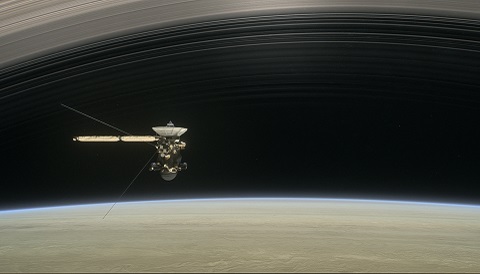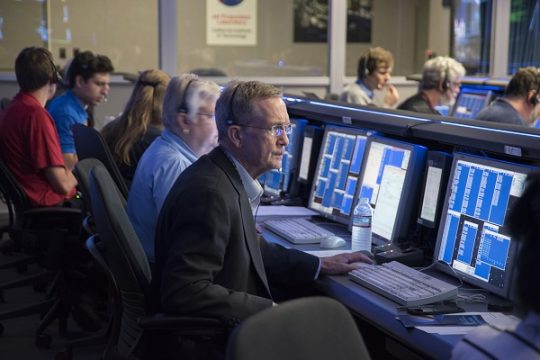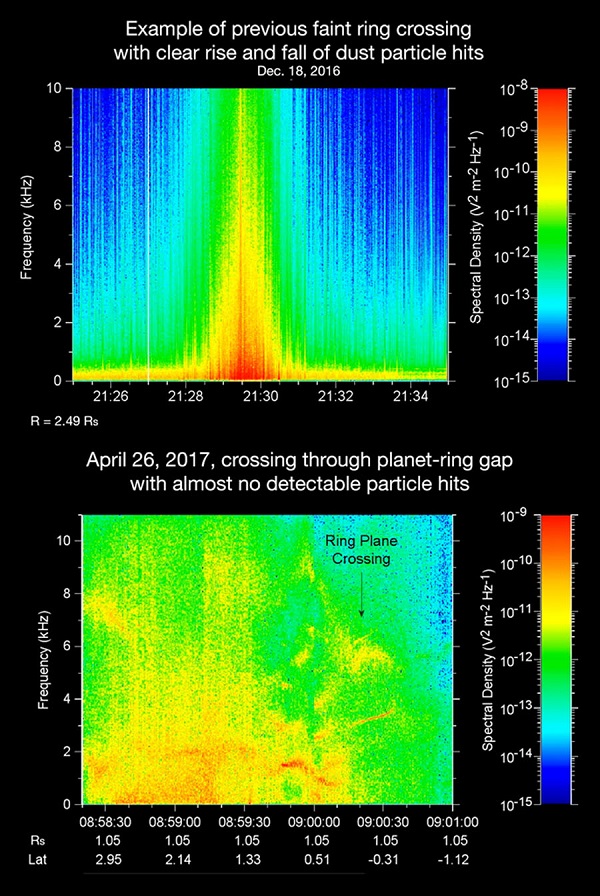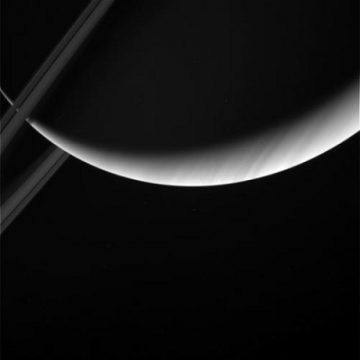As NASA's Cassini spacecraft sails through a clear gap between Saturn and its rings as part of its Grand Finale orbits, it found less than expected.

NASA-JPL / Caltech
In science, absence can be as meaningful as discovery. Such a moment occurred last week, as NASA's Cassini spacecraft cruised through the gap between the planet Saturn and its rings at 77,000 miles per hour, with nary a hit from dust particles. The discovery, or rather the absence of discovery, comes during Cassini's dramatic “Grand Finale” phase; the spacecraft will thread the gap 21 more times before its demise on September 15th.
“The region between the rings and Saturn is 'the big empty,' apparently,” says Earl Maize (NASA-JPL) in a recent press release. “Cassini will stay the course, while scientists work on the mystery of why the dust level is much lower than expected.”

NASA / JPL-Caltech / Bob Paz
Though this absence of threatening debris comes as a relief for engineers worried about the safety of the mission, it's also a bit of a surprise for planetary scientists working to understand just what the paucity of dust means for the rings' formation.
Threading the Rings
Cassini made the first dive through the estimated 1,200-mile- (2,000-km-) wide gap on April 26th. Watch the video of what it saw here:
Cassini oriented its large 13-foot (4-meter) wide main dish forward to act as a debris shield. This measure shields the spacecraft's main bus, though two instruments extend out beyond the diameter of Cassini's main dish: its magnetometer and the Radio and Plasma Wave Science (RPWS) detector. Both instruments were active during the April 26th pass between the rings and planet. Though the RPWS detected hundreds of hits from smoke-sized particles during last year's Ring Grazing Orbits, it only registered a few hits as the spacecraft crossed the ring plane just outside the outermost F Ring.
You can “hear” what the ring-plane crossing sounds like in RPWS data, converted to eerie audio:
“It was a bit disorienting — we weren't hearing what we expected to hear,” says. William Kurth (University of Iowa) in a recent press release. “I can probably count on my hands the number of dust particle impacts that I hear.”
The few particles that struck Cassini's instruments were on the order of a micron across. This is also good news, as engineers won't have to keep the main dish rotated forward on future passes through the ring plane, enabling the other science instruments to collect data.

NASA / JPL-Caltech / University of Iowa
Cassini just completed its second pass through the ring plane on Tuesday, May 2nd, at 3:38 p.m. EDT (19:38 UT). Tuesday has become “ring-plane-crossing day,” as Cassini is now on a looping elliptical orbit around Saturn once every week. The engineers have also instructed Cassini to rotate faster than previously, in an effort to calibrate its magnetometer for subsequent passes.

NASA/JPL-Caltech/Space Science institute
But sampling of dust isn't Cassini's only goal during its Grand Finale orbits. Cassini will also sample Saturn's tenuous outer atmosphere during closer-in passes. Expect more stunning vistas, as Cassini's camera Imaging Science Subsystem (ISS) pans along the ring plane, as well as the surface of the planet itself, on subsequent passes. Each swing through the ring plane also precesses along the longitude above the planet itself, giving scientists a “taste” of different zones. Perhaps, unknown clumps of dust may yet inhabit the zone between the planet and its rings?
Finally, Cassini's Radio Science Subsystem (RSS) is also carrying out a series of radio occultation experiments starting on Grand Finale orbit 3, to be conducted as the rings pass between line of sight with Earth. Around this time, the RSS will also perform Doppler shift measurements to probe Saturn's interior. Not only will Cassini map out the gravitational field of Saturn in unprecedented detail on future passes, but the occultation experiments should give us a refined estimate of the overall mass of Saturn's rings.
Engineers also hope to use Cassini's Cosmic Dust Analyzer (CDA) to scoop up ring dust starting on Grand Finale pass 4, in an effort to gauge just how old Saturn's rings are. Then, starting in late May, Cassini will begin using its powerful synthetic aperture radar — the same instrument that mapped the methane seas of Titan earlier in the mission — to scan along the A ring out through the C ring, wit a resolution between 4 kilometers and 100 meters per pixel.

NASA / JPL-Caltech
There's no doubt that the final phase of Cassini's mission is the most hazardous: that's why engineers are getting a bit braver with NASA's precious eye around Saturn as it nears the end of its life. Final “self-destruct” via atmospheric entry just over four months from now is already set in motion with Cassini's current ballistic trajectory. Even if it becomes a disabled derelict, destruction is assured, a move that protects Saturn's moons from future contamination.
Watch for more great Cassini science to come, right up until the very end.
 0
0









Comments
You must be logged in to post a comment.